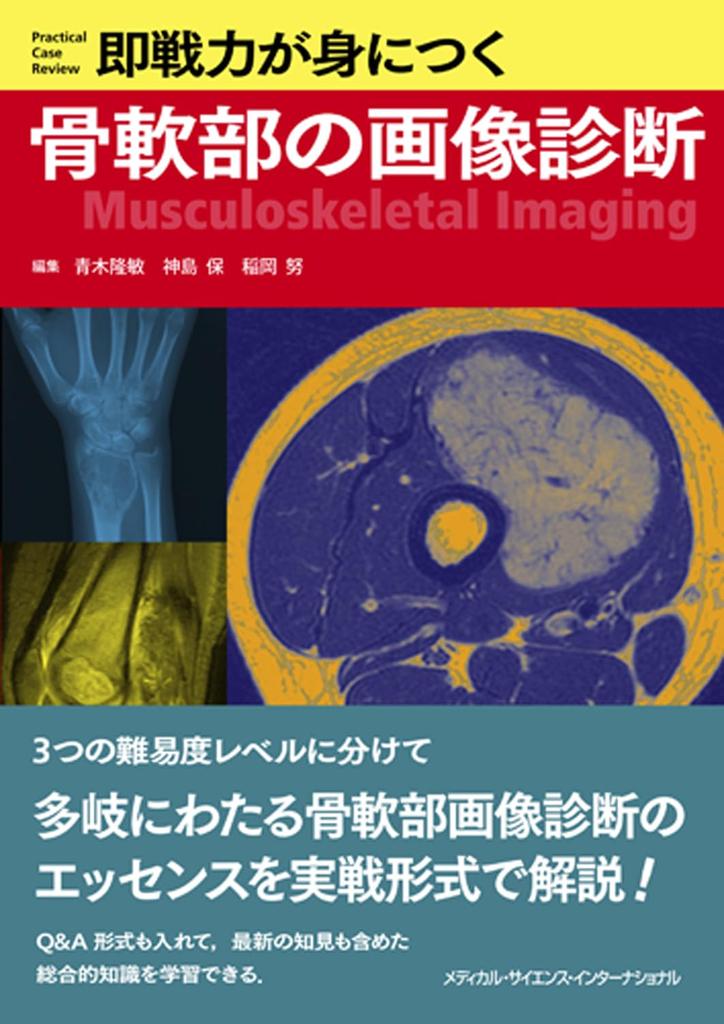Divided into three difficulty levels, this practical guide explains the essence of a wide range of bone and soft tissue imaging diagnostics!
Following "Brain," "Head and Neck," "Liver, Gallbladder, Pancreas," and "Chest," this fifth volume covers all major topics. This practical textbook begins with a presentation of the presenting condition, then presents case images, explains the findings, and clarifies the diagnosis (disease name). The largest number of diseases in the series, 155, are divided into three difficulty levels, with randomized placement within each level to prevent inferring the diagnosis. The second half of the book thoroughly explains the disease and provides additional information on differential diagnosis. Q&A-style questions are also included, making it useful for specialist examinations. Ideal for improving the skills of radiology and orthopedic surgery residents and specialists.
This book, the fifth in the "Imaging Diagnostics for Immediate Use" series, was designed to provide a volume directly linked to clinical practice in bone and soft tissue imaging diagnostics. Following the concept of previous volumes, it explains 155 diseases classified into 18 disease categories. For each of these 155 diseases, the book describes clinical features such as age and medical history, imaging findings, and final diagnosis and progression. It then presents Q&A questions, key imaging diagnostic criteria, explanations of each disease, and differential diagnoses. Finally, the answers to the Q&As are provided, effectively organizing the key points for each disease. To facilitate learning based on each reader's level of proficiency, the cases are categorized by difficulty into "Introductory Level (level intended for the specialist examination)," "Proficiency Level (level intended for the diagnostic specialist examination)," and "Challenging Level (level intended to enhance the skills of a diagnostic specialist)," making the book accessible to a wide range of levels.
While some bone and soft tissue diseases are common to each joint/body part, many are unique to each joint/body part. Furthermore, there are numerous types of bone and soft tissue tumors, and countless diseases that fall into other categories, including rare ones. While the 155 diseases are the largest number of diseases included in the series to date, this is the result of narrowing down the many diseases initially considered as much as possible to keep the content as compact as possible, leaving only the minimum number of diseases. While there are still many diseases in the bone and soft tissue field that readers should be aware of, we believe that by making good use of this practical book, readers will be able to fully understand the essence of bone and soft tissue imaging. This book is ideal for efficient learning for residents aiming to obtain specialist certification and for readers who do not specialize in bone and soft tissue. It will be a great help to those aspiring to become bone and soft tissue diagnostic radiologists.
Bone and soft tissue diagnostic imaging often begins with plain X-rays, but MRI, with its superior contrast resolution for bone and soft tissue, has come to play a central role in imaging diagnosis. Diagnostic radiologists, in particular, are increasingly being asked to use MRI for qualitative and extensive diagnosis. Given this background, while trauma and bone tumors can often be diagnosed with plain X-rays alone in clinical practice, this book contains the most MRI images, which are often the focus of diagnostic radiologists. However, we also make every effort to cover and explain plain X-ray findings, which are the first step in bone and soft tissue diagnostic imaging. We hope that residents aiming to obtain specialist certification will gain the comprehensive knowledge necessary for bone and soft tissue diagnostic imaging.
Finally, we would like to express our sincere gratitude to all the bone and soft tissue diagnostic radiologists across the country who responded to the project's purpose and wrote this book despite their busy schedules in their daily work, and to Mr. Masamichi of Medical Science International, who has provided generous support since the project began two years ago.
March 2025
Editor
[Table of Contents] (Number of diseases in parentheses)
Tumors and Tumor-Like Disorders (Bone 19, Joint 3, Soft Tissue 27)
Blood and Bone Marrow Disorders (3)
Fractures (8)
Joint Trauma and Injuries (Shoulder 6, Elbow 4, Hand/Wrist 4, Hip 6, Knee 4, Ankle/Foot 5)
Soft Tissue Trauma and Injuries (3)
Metabolic and Endocrine Disorders (2)
Deposition Diseases (3)
Drug-Induced and Other (4)
Normal Variations and Normal Processes (5)
Congenital Disorders (Skeletal Disorders 4, Metabolic and Endocrine Disorders 3)
Infectious and Inflammatory Disorders (Bone 3, Joint 3, Soft Tissue 2)
Ischemia (4)
Other Bone Lesions (Epiphyseal Disease 2, Phaevisiae 2, Osteoproliferative Disorders 1)
<Spine and Spinal Cord>
Infectious and Inflammatory Disorders (3)
Tumors and Tumor-Like Disorders (Primary Spinal Tumors 3, Tumor-Like Disorders) 1)
Trauma (5 cervical fractures/dislocations, 3 thoracic/lumbar fractures)
Degenerative spinal diseases (7)
Other spinal disorders (3) (Numbers in parentheses indicate the number of diseases; 18 disease categories, 155 in total)
























